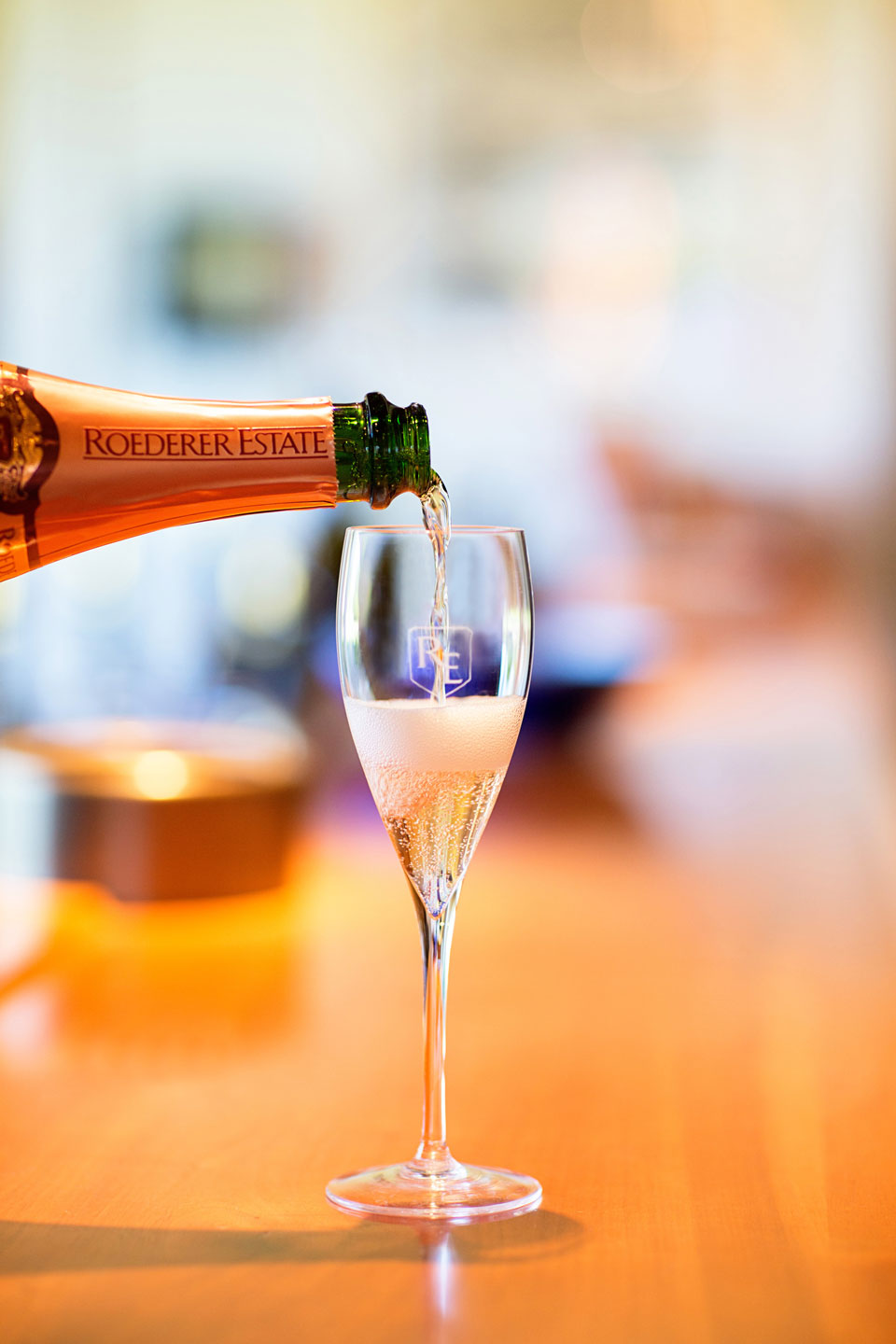Roederer Estate’s Award-Winning Sparkling Wines

by Ree Slocum
When Roederer Estate was planning their tasting room and winery in Anderson Valley, they considered that many people from the Bay Area, as well as locals, use Highway 128 from Cloverdale when traveling to the coast. The “wine road” wanders through miles of vineyards, trees, rolling hills, and the quaint, yet hip, little towns of Yorkville, Boonville, Philo, and Navarro. Fine eateries and wine tasting rooms are peppered throughout the corridor, some with international reputations, inviting harried travelers to slow down, unplug from the hustle and bustle of normal life, and sample the delightful treats awaiting.
Arnaud Weyrich of Roederer Wines
Roederer built their winery and tasting room into a hill nestled in the shade of trees and surrounded by the lush Roederer Estate vineyards. The beautifully-designed tasting room is bordered by flowers and shrubs and is staffed with warm and knowledgeable people who help provide guests with the Roederer experience. A large, verdant lawn combined with patio seating and umbrellas are right outside, and the grass beckons children and dogs to frolic as adults enjoy their wine. Roederer has created an ambience which encourages relaxation and enjoyment of the location, fellow travelers, and their crisp and elegant sparkling wine.
Arnaud Weyrich, VP of production and winemaker at Roederer Estate, spoke about the atmosphere they strive to create. “The tasting room is tucked back from the highway, taking a step away. I’ve always thought of us as blending into nature. We thought it’d be great to offer people a rest stop on their way to the coast or to the valley. They could slow down, park their car, enjoy the patio overlooking the valley and mountains surrounding them. Maybe meet friends here and take in the feeling of the place created by Roederer. You can sip a glass of bubbles, and talk and remake the world,” he laughed.
the tasting room at Roederer Estate
Arnaud first found his way to Roederer Estate as an intern after graduating from Ecole Supérieure d’Oenologie, a prestigious school in France renowned for its winemaking and vineyard management program. He left the organization for a few years and returned to Roederer in Philo along with his wife and two children in 2000, as assistant winemaker and supervisor of operations. Arnaud muses, “Once you discover a place, you either hate it or you love it. I was part of the second group.” He has a love for Mendocino County, with its “sense of remoteness, wilderness all around you, rugged terrain and the rough Pacific Ocean next door, and a way of life that’s different. And you’re not that far from the Bay Area and San Francisco.”
When asked about differences between champagne and sparkling wines, Arnaud explained that there are specific rules and laws in the various French appellations for growing and making wine. Champagne is the term for sparkling wine grown and created in the Champagne appellation in France. Chardonnay, Pinot Noir, and Pinot Meunière make up 98% of grapes planted in the Champagne region, though a particular champagne can be created using a single variety up to as many as seven varieties of grapes.
In the US, there are no rules or laws governing growing and making sparkling wine, and “appellation” basically means “region,” which is registered as an AVA (American Viticultural Area). In Anderson Valley’s AVA, Roederer Estate uses the same time-honored tradition of growing and blending Chardonnay and Pinot Noir grapes and wine, but they do not add Pinot Meunière. Their organic and biodynamically grown grapes are harvested from the Estate’s own vines. Then, according to their website, “Oak-aged wines from the estate’s reserve cellars are added to the blend, creating a multi-vintage cuvée in the traditional Louis Roederer style.”
With his soft French accent, Arnaud described his winemaking style at Roederer: “This isn’t wine made by one person. It’s not just me. It’s team work. There was somebody before me, and there’ll be somebody after me. There’s a house style that we want to be able to repeat to bring that consistency of who we are. Then I bring a little bit of something of myself . . . a sensitivity to what the wine brings. It’s to bring pleasure. It is something that is a pleasure wine but also that’s serious. It’s been aged and blended in a way you can have fun with but also pairs with food.” Neither food nor wine should overpower one another, Arnaud added. “They need to complement each other. That’s what I’m trying to do in making these wines.”
According to the winemaker himself, Roederer Brut pairs well with oysters and shellfish. Brut Rosé is fantastic with salmon, pizza, and pasta. L’Ermitage has aged five years longer and can go with more serious food that has a lot of butter or cream, like aged hard cheeses that tend to show nutty flavors such as French Comté or Boont Corners from Pennyroyal. L’Ermitage Rosé works well with more salty cheeses such as Parmegiano Reggiano, as well as Dungeness Crab cake and steak tartare.
We rarely take the time to slow down, and to do so feels almost indulgent. So indulge! Next time you find yourself ready for a treat, surround yourself with nature, good friends, and a glass of Roederer’s bubbles (and sometimes food pairings) at Roederer Estate’s tasting room.
Roederer Estate
4501 Highway 128, Philo, California
(707) 895-2288 | roedererestate.com
Ree Slocum is a fine art freelance photographer and writer who calls the edge of the wilds in Mendocino County “home.” She takes pleasure living with bird song, the breathing fog, and wildlife’s cast of characters when not on assignments. See more at reeslocumphotography.com.
Photos pp 31 & 33 courtesy of Roederer Estate. Photos p 32 by Ree Slocum.



